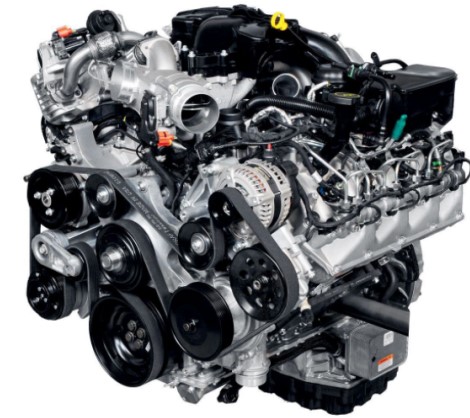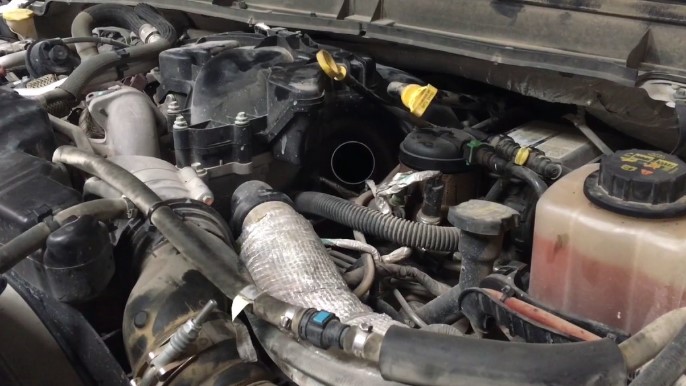For those who crave power in their trucks, the allure of a turbocharger is undeniable.
A turbocharger, often termed “turbo,” is a marvel in enhancing fuel efficiency and curbing detrimental emissions.
Yet, while turbos amplify engine prowess, they aren’t without issues. Over time, a turbo might deteriorate, leading to potential failure.
This piece sheds light on the telltale signs of a malfunctioning 6.7L Powerstroke turbo and offers insights into addressing these concerns.
💥
Indicators of 6.7L Powerstroke Turbo Malfunction

The initial hint of a faltering turbo is often an unusual smoke emission or a noticeable oil deficit in one’s vehicle.
Additionally, odd sounds, such as a whine or rattle, might emanate, culminating in a perceptible reduction in vehicle speed. Such manifestations are not uncommon in the 6.7L Powerstroke turbos when they’re on the fritz.
🚀Recommended article:
6.7L Powerstroke Turbo Failure Symptoms Unveiled:
Turbo troubles can manifest in various ways. Delving into these symptoms aids in pinpointing 6.7L Powerstroke turbo issues:
- Rampant Exhaust Smoke
- A turbo’s primary design is to curtail exhaust smoke. An abundance of it signals a malfunction. The presence of blue and black smoke is particularly alarming.
Due to a fractured turbo casing, oil seepage into the combustion chamber results in blue smoke. Conversely, black smoke might arise from many issues, including a compromised engine, obstructed air filters, or flawed fuel injectors.
At its core, if the turbo’s exterior is damaged or its seals deteriorate, the oil will seep into the exhaust, leading to significant smoke emissions.
- Lackluster Acceleration
- A turbo’s essence lies in amplifying a vehicle’s speed. A sluggish acceleration or diminished power output hints at a compromised turbo.
- Jarring Siren-like Sounds
- While turbos are synonymous with pleasant auditory experiences, any abrupt, loud noises are red flags, possibly pointing to damaged components within the turbo system.
- Elevated Oil Usage
- An uptick in oil consumption might indicate a turbo leaking oil, a precursor to its eventual failure.
- Illuminated “Check Engine” Light
- While ambiguous, an illuminated engine light could be indicative of turbo troubles. Seeking expert opinion is paramount.
- The Boost Gauge
- Certain vehicles with a boost gauge provide real-time turbo performance data. A dip in readings is concerning.
- Distinctive Blue and Black Smoke
- Oil seepage due to turbo casing cracks leads to blue smoke. In contrast, various factors, including a malfunctioning engine or clogged components, result in black smoke. Observing such emissions, especially post-idling, warrants immediate attention.
Addressing 6.7L Powerstroke Turbo Issues
Upon identifying a faulty 6.7L Powerstroke turbo, replacement might be the next logical step.
Prompt consultation with a seasoned technician is advisable. Procrastination only escalates the damage and the subsequent repair costs. Professionals can assess the situation and guide potential turbo replacement.
📢Read also:
The Financial Implication of Turbo Replacement
Given the turbo’s significance, replacement is costly. The exact expenditure hinges on the specific 6.7L Powerstroke engine variant. On average, a Ford 6.7L Powerstroke turbo replacement oscillates between 2300$ to 2900$, with labor costs ranging from 360$ to 460$.
Maintenance Insights for the 6.7L Powerstroke Turbo
Heat and lubrication are pivotal for turbos. Due to the turbo’s rapid rotations, traditional bearings are prone to early failures.
Turbochargers employ fluid bearings, leveraging a thin oil layer to mitigate wear and maintain optimal temperatures. Most turbo failures stem from inadequate lubrication or oil contaminants.
Regular oil changes, diligent oil and air filter maintenance, and oil pressure monitoring are crucial. Additionally, one can self-inspect the turbo for anomalies, ensuring all related systems function seamlessly.
⚡️Another article:
In Conclusion
While turbos are engineered to augment engine performance, their failure can be detrimental. Recognizing the symptoms above and seeking expert intervention is paramount.
